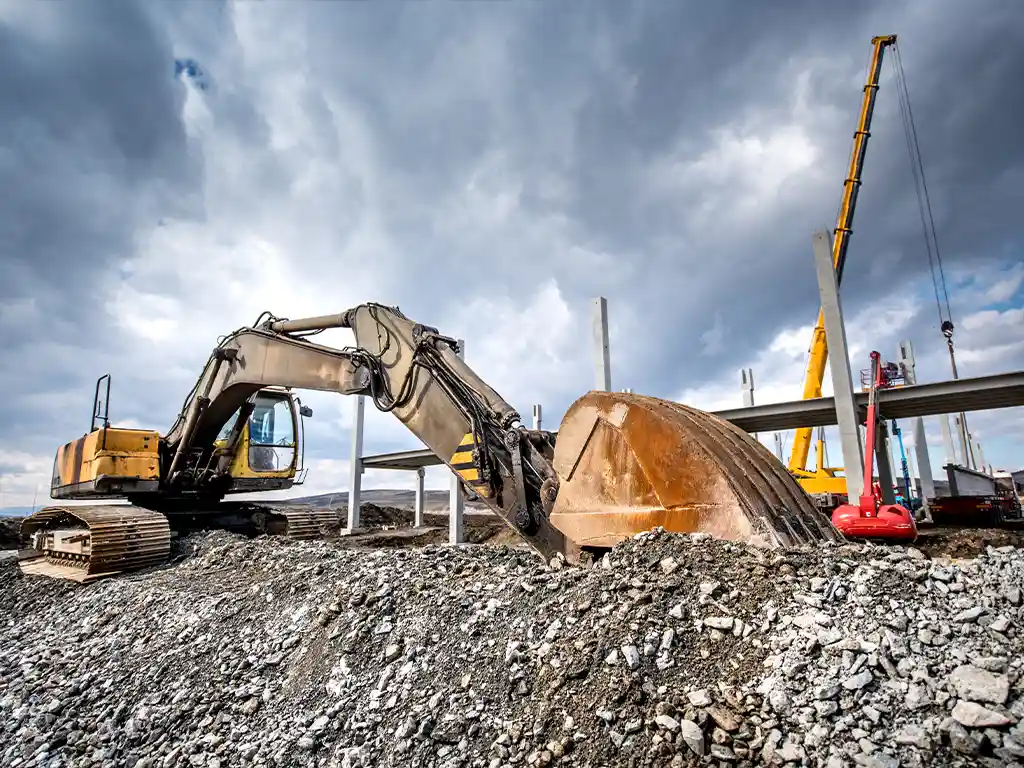In the dynamic realm of construction, mastering the intricacies of construction logistics is pivotal for project success. This discipline, though often overshadowed by more visible aspects of construction, underpins efficiency and cost-effectiveness. By seamlessly orchestrating the movement and storage of materials, equipment, and personnel, construction logistics ensures projects are completed on time and within budget. As we delve into the essentials of construction logistics planning, this guide will provide expert insights and strategies to optimise your construction projects from inception to completion.
Understanding the Importance of Logistics in Construction Projects
The role of logistics in construction cannot be overstated. At its core, logistics involves the precise management of resources to ensure that every facet of a project aligns seamlessly. One startling revelation is that approximately 30% of the work performed by construction companies often ends up as rework. This not only affects the timeline but also contributes to about 5% of the project’s total contract value on average. Addressing logistics inefficiencies can significantly reduce these figures, ultimately contributing to a project’s success and profitability.
Developing a Comprehensive Logistics Plan
Creating a comprehensive logistics plan is fundamental for any successful construction project. This process begins with detailed procurement planning to ensure that materials arrive precisely when needed, thereby minimising delays and storage costs. Additionally, strategic storage solutions must be devised to keep materials safe and accessible, without causing site congestion. Efficient transportation planning is also crucial, involving route optimisation to reduce travel time and fuel costs.
Manpower and equipment deployment should be meticulously scheduled to ensure that each phase of the project is adequately staffed and equipped. This requires a thorough understanding of the project timeline and critical milestones. Identifying potential bottlenecks in advance allows for the allocation of additional resources where necessary, preventing disruptions.
Effective logistics planning also hinges on robust communication channels among all project stakeholders. Establishing clear reporting structures and regular check-ins ensures that everyone is informed and can address issues promptly. Utilising technology, such as project management software, can facilitate this communication, providing real-time updates and enhancing coordination.
Overall, a well-crafted logistics plan integrates all these elements, paving the way for a streamlined, efficient construction process.
Utilising Technology for Optimised Logistics
Innovative technology is revolutionising construction logistics, offering new ways to enhance efficiency and reduce costs. Virtual Design and Construction (VDC) tools have proven particularly valuable, allowing for detailed project visualisations that preempt potential issues. Kim Hagger, Director of Business Integration at Haselden Construction, highlights that VDC technology saved their company $100,000 by eliminating rework, thus avoiding the need to reorder materials and repurpose man-hours.
Advanced project management software also plays a crucial role by offering real-time updates and facilitating seamless communication among stakeholders. These platforms enable efficient tracking of materials, equipment, and personnel, ensuring that all components of the logistics plan are synchronised. Additionally, technologies such as Building Information Modelling (BIM) provide a collaborative environment where data is shared across the project lifecycle, thereby enhancing coordination and decision-making. Embracing these technological advancements allows for a more streamlined logistics process, reducing delays and minimising costs.
By integrating cutting-edge tools and software into logistics planning, construction projects can achieve higher levels of efficiency and effectiveness, ultimately leading to improved project outcomes and greater profitability.
Coordination and Communication Among Stakeholders
In construction logistics, fostering effective coordination and communication among stakeholders is paramount. Establishing a centralised communication platform enables architects, engineers, contractors, and suppliers to share updates and address issues in real time. Regularly scheduled meetings and clearly defined reporting structures are essential for maintaining alignment and mitigating the risks that arise from miscommunication. By keeping all stakeholders informed and engaged, a collaborative environment is nurtured, which is vital for the successful execution of logistics plans. Utilising project management software can further streamline this process, offering real-time updates and facilitating seamless coordination. This integration of technology ensures that everyone involved has access to the most current information, thereby enhancing decision-making and overall project efficiency.
Risk Management and Contingency Planning
Risk management and contingency planning are essential for navigating the complexities of construction logistics. Identifying potential risks, whether from supply chain disruptions, labour shortages, or adverse weather, enables the formulation of robust contingency measures. Anticipating these challenges helps project managers develop strategies that mitigate their impact, ensuring the project remains on schedule and within budget.
Effective risk management begins with a thorough risk assessment, identifying vulnerabilities across all project phases. This includes scrutinising supplier reliability, transportation routes, and workforce availability. Once potential risks are identified, the next step involves creating detailed contingency plans. For instance, establishing alternative suppliers can safeguard against supply chain disruptions, while flexible staffing arrangements can address unexpected labour shortages.
Another critical aspect is maintaining open communication channels among all stakeholders. By ensuring that everyone is aware of potential risks and contingency plans, the team can respond swiftly to any issues that arise. Utilising advanced project management software can aid in this process, offering real-time updates and facilitating seamless coordination.
It’s also crucial to allocate resources for risk management activities, such as maintaining emergency funds and setting aside time for risk mitigation tasks. Regular training and drills can prepare the team for various scenarios, ensuring that everyone knows their role in implementing contingency plans.
Incorporating these practices into your logistics planning not only safeguards your project from unforeseen disruptions but also enhances overall resilience and adaptability.
Cost Control Through Efficient Logistics
Efficient logistics planning is paramount for cost control in construction projects. By meticulously managing the allocation and movement of resources, it’s possible to achieve substantial savings. Lean construction techniques, which focus on maximising value while minimising waste, are particularly effective in this regard. Just-in-time delivery systems, for example, ensure materials arrive precisely when needed, thereby reducing the costs associated with storage and excess inventory.
Strategic planning also involves optimising transportation routes to minimise fuel consumption and travel time, which can significantly lower operating expenses. Employing advanced project management software can aid in monitoring these logistics, providing real-time data to make informed decisions that prevent overspending.
Additionally, resource pooling—sharing equipment and labour across multiple projects—can lead to economies of scale, further reducing costs. Collaborative efforts among contractors, suppliers, and other stakeholders can streamline procurement processes, enabling bulk purchases and negotiated discounts.
By integrating these strategies into your logistics planning, you not only control costs but also enhance project efficiency and sustainability. The result is a construction process that remains within budget while maintaining high standards of quality and performance.
Environmental Considerations in Construction Logistics
Sustainability is increasingly becoming a priority in construction logistics. The environmental impact of construction activities is significant, with up to 30% of building materials ending up as waste, which contributes to 150 million tonnes of landfill waste annually. Addressing these environmental concerns through thoughtful logistics planning is imperative. Strategies such as recycling materials, reducing transportation emissions, and implementing eco-friendly practices can significantly lessen the ecological footprint of construction projects.
Incorporating sustainable practices in logistics planning begins with material selection. Opting for recycled and locally sourced materials not only reduces the demand for new resources but also minimises transportation distances, cutting down on fuel consumption and emissions. Furthermore, efficient waste management strategies are essential. By segregating waste at the source and promoting the reuse of materials, the volume of waste sent to landfills can be dramatically decreased.
Transportation is another critical area where environmental impact can be mitigated. Utilising electric or hybrid vehicles for transporting materials and equipment can significantly reduce greenhouse gas emissions. Route optimisation, as discussed earlier, also plays a pivotal role in minimising travel distances and fuel usage.
In addition to these measures, adopting green building certifications, such as BREEAM or LEED, can guide the implementation of sustainable logistics practices. These frameworks provide comprehensive guidelines for reducing the environmental impact of construction activities, from planning through to execution.
Lastly, fostering a culture of sustainability among all stakeholders is crucial. Regular training and awareness programmes can ensure that everyone involved in the project is committed to environmental stewardship, thereby enhancing the overall effectiveness of green logistics initiatives.
Continuous Improvement and Feedback Loops
Continuous improvement and feedback loops are vital for the ongoing refinement of construction logistics. By consistently evaluating logistics strategies and gathering input from all stakeholders, construction managers can pinpoint areas needing enhancement. Implementing adjustments based on this feedback allows logistics processes to become more efficient over time. This iterative approach ensures that lessons learned from each project are incorporated into future planning, fostering a culture of perpetual advancement.
To effectively utilise feedback loops, establish regular review sessions where project teams can discuss successes and challenges encountered. Encourage open communication and a non-punitive environment where issues can be addressed constructively. Additionally, leveraging data analytics tools can provide objective insights into logistics performance, identifying patterns and trends that might otherwise be overlooked.
Integrating feedback mechanisms into your logistics planning not only enhances current project efficiency but also builds a repository of best practices for future initiatives. This continuous cycle of assessment and improvement underpins long-term success in the construction industry, ensuring projects are not only completed on time and within budget but also set new benchmarks for operational excellence.

